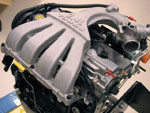
|
The specific engine we tore apart for this story is from a PT Turbo, but the
guts are the same as the SRT-4's engine; only the intake manifold and turbo
plumbing is different |
| Enough with the sales pitch. It's clear that the SRT-4 will be the Omni GLH
of the 2000s, and plenty of guys hungry to flip the bird to the import compacts
will happily pay the sub-20-Gs sticker price, then hose the car down with speed
goodies. This story may also be of interest to those without an SRT-4, as the
2.4L was introduced in '94 in the Stratus, Cirrus, and the minivans, and it
still appears in those applications. The base 2.4L is also current in the PT
Cruiser, and it's called Power Tech in the new Jeep Wrangler SE and Liberty. The
Jeep applications mean that rear-drive bellhousings are available for the 2.4,
and it's rumored that the Dodge Razor concept car may see production as a
turbo-2.4L-powered, rear-drive two-seater. The 2.4 is also similar to the SOHC
and DOHC 2.0L engines used in various Neons, Breezes, Stratuses, Avengers, and
Sebrings since '93, but the 2.0L block has a lower deck height (8.35 versus 9.38
inches), does not have balance shafts, and may have other interchangeability
issues we can't vouch for (though the 2.0L DOHC does use the same cylinder head
as the 2.4L).
To get a leg up on the workings of the boosted 2.4L powerplant and its
performance potential, we had the rare treat of spending a day at
DaimlerChrysler's Tech Center in Auburn Hills, Michigan, with the guys who
designed the turbo version of the 2.4L engine--and there's a lot more to it than
just the hairdryer.
|
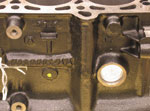 |
While the turbo 2.4 is the same basic configuration as the NA
version, the casting has some slight revisions that we will outline,
and it can be identified by the T cast into the front (intake) side,
of the block. These are currently in '03 PT Turbos and SRT-4s, but
will also be used in '04 naturally aspirated applications |
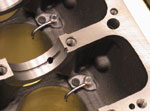 |
A significant addition to the
turbo block is the inclusion of an extra oil gallery that is
tapped for piston squirters in four positions. These spray oil on
the underside of the pistons to cool the domes for durability and
to prevent preignition due to elevated combustion-chamber temps.
All '04 blocks will have this provision, but squirters will not be
used on NA applications |

|
Another upgrade for the turbo
that will find its way to all '04 versions is a water-jacket
upgrade that's barely visible as a slight bump in the triangular
openings on the deck surface (arrow). Using Computational Fluid
Dynamics (CFD) analysis, DaimlerChrysler engineers were able to
model the fluid flow through the block and create ramps in the
water passages that direct as much as six times the mass of
coolant between the cylinders. |
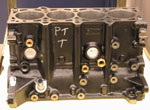
|
The turbo block also needed a few
extra passages to accommodate oil to the turbo and a remote oil
cooler. This is all on the backside of the block, or the exhaust
side, for a front-drive application. On a rear-drive Jeep or the
funky hot rod of your choice, it'd be the passenger side. In a
front-drive, the cylinders are numbered 4-3-2-1 from driver to
passenger side |
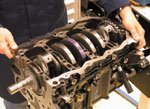
|
The 3.98-inch-stroke crank is a
nodular iron casting, but with increased surface hardness as
compared to NA engines. It's retained by an iron bed plate that
incorporates all the lower halves of the main-bearing journals.
The plate is located on dowels and must be tapped into place with
a rubber mallet, then torqued to 30 lb-ft plus 90 degrees on the
mains and 21 lb-ft on the outer perimeter bolts. Mopar nonaerobic
sealer PN 4773257 must be used between the block and the bed
plate. The bearing material is aluminum-tin alloy on a steel
backing, and a contoured thrust surface was added to the thrust
bearing. |
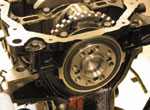
|
Earlier 2.4L engines use a crank
counterweight cast with eight integral reluctor windows for the
computer's fuel and spark timing. The new 2.4 uses a separate
machined wheel with 32 windows fastened to the rearmost
counterweight and is used with a more advanced computer. The new
cranks have a machined pad for the reluctor and do not have
drilled rod pins. The old block can be identified with a pickup
midway down the rear of the block, while the new one is nearer the
flywheel. Also note the one-piece rear main seal; Miller makes an
installer tool. |
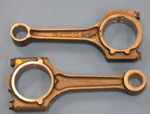
|
The turbo connecting rods
(bottom) have balance pads whereas the NA rods (top) do not. Also,
the turbo rods are of C-70 forged steel rather than the
powdered-metal construction of the NA rods, though both versions
used cracked caps. Both rods weigh the same at the big end, aiding
in production-line assembly of these internally balanced engines.
The turbo rods are drilled with squirt holes to oil the cylinder
walls and require unique bearings with feedholes. Turbo rods use
floating piston pins while NA versions are pressed. The M9 bolts
get 20 lb-ft plus 90 degrees. |
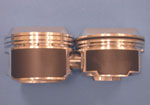
|
The NA piston is on the left, the
new turbo version on the right. CFD analysis and dyno testing
showed that the ski-jump-shaped dome on the piston was desirable
for performance, so compression ratio was reduced to 8.1:1 by
decreasing the piston compression height to lower piston position
in the cylinder. Both versions are Mahle eutectic castings with
Mahle Grafal skirt coating, but the turbo version also has a
hard-anodized top ringland, a moly-coated 1.2mm top ring and has a
shorter skirt, contributing to the 335-gram weight |
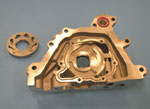
|
The oil pump is driven from the
snout of the crank, and its housing completes the oil-pan seal.
The gerotor-type pump was redesigned to increase output to feed
both the turbo and the piston squirters, and it moves 15 cc's of
oil per revolution compared to 12 cc's with the previous version.
This pump is now used on both turbo and NA 2.4 engines, and is
identified by a T on the housing casting. |
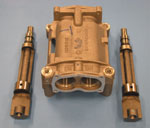
|
The balance-shaft assembly
includes a housing, two shafts, and a chaindrive with tensioner
driven from the crank snout. The parts are labeled clearly to
avoid mistiming them, though in full-race applications where
vibration is not an issue it would be OK to leave them out
entirely. There's an oil-feed hole that must be plugged to omit
the balance assembly. |
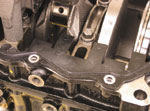
|
Here's a neat tip that we'd like
to see available for our musclecar V-8s: The oil-pan gasket has
tabs that act as an integral crank-scraper for oil control. The
oil pan is a cast-aluminum unit designed mostly for noise,
vibration, and harshness suppression; we suspect Moroso will offer
performance versions. |
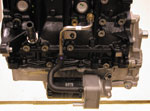
|
Oil routing and filter-pad
location vary with the vehicle application. The PT Turbo and SRT-4
uses this oil cooler with integral filter boss. |
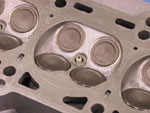
|
The cylinder head is the same for
turbo and NA engines, though the boosted application uses
Silchrome-1 intake valves and Inconel exhaust valves. The head
uses a four-valve, dual-overhead-cam design, with a pent-roof
chamber, centrally located spark plug, and quench areas on both
sides of the chamber. The turbo head gasket is an upgraded
three-layer design. |
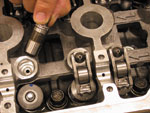
|
Hydraulic cam followers are used
in the 2.4L along with roller followers with a ratio of 1.78:1 on
the base circle and 1.71:1 on the nose of the lobe. For degreeing
the camshafts, Mopar Performance offers solid lifter PN P4452014. |
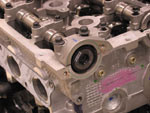
|
The cam retainers are numbered
front-to-back and left or right, and there are caps front and rear
that require Loctite 518 anaerobic sealer. The cam-seal press tool
is Miller C4680-1. Note the cam-sync pickup at the end of the
intake cam. |
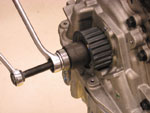
|
Another special tool, Miller
6792-1, is needed to press the drive for the cam timing belt. This
pulley is a cool powdered-metal design, and it rides behind the
damper. |
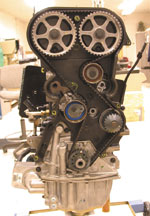
|
Here's the completed cam-drive
setup minus the stock damper and plastic timing cover. The cams
are the same as the NA application, and aftermarket grinds as well
as adjustable timing gears should be available soon. |
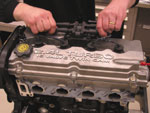
|
The turbo versions of the 2.4L
use a cast-aluminum cover as opposed to composite, and they have a
trick internal baffle system to cope with turbo pressures. It's
also isolated on rubber for noise suppression. Check the neat coil
and wire setup. |
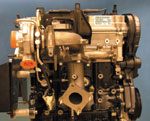
|
The meat of it comes with the
all-new exhaust manifold, a casting that's integral with the
turbine housing for the turbocharger. The turbo assembly can be
split in two between the compressor and the turbine, but it is not
recommended. The turbo itself is a Mitsubishi reverse-rotation
model with a 6-square-centimeter inlet and an integral
surge-valve/wastegate and both oil and water cooling; it peaks at
14 psi through the intercooler. |
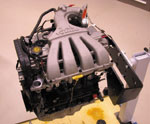
|
There are two intake manifolds
and intercooler designs for the 2.4, one for PTs and another for
SRT-4s. The engineers tell us the designs are similar in power
production, and modeled mostly for packaging under the hoods. This
is the long-runner PT Turbo intake; the SRT-4 version is much
lower and smaller, with shorter runners. Both use the same
throttle-body, which is common to the NA engines as well. |
|
|
|
The ECU End of It
The turbo 2.4L is the first boosted engine to use
DaimlerChrysler's Next Generation Controller. As the SAE paper describes,
"The NGC algorithms are 'model-based,' continuously calculating the
appropriate control parameters to keep the engine at its desired performance.
This is a departure from past control strategies that relied on pre-programmed
tables of operating conditions." The system is speed density rather than
mass air.
Interestingly, the wastegate control is dictated by
throttle demand rather than a simple blowoff at a set boost pressure. This
way, the computer can estimate the power needs of the driver and either
provide boost pressure or not. The good news is that you may get more boost in
some conditions than a basic mechanical blowoff might provide; the bad news is
that the computer "can also reduce the torque as required to ensure
powertrain durability," per the SAE paper. The system uses an air charge
temp (ACT) sensor after the intercooler as well as a throttle inlet pressure
(TIP) sensor. The combined information can predict turbo compressor speed and
pressure drop across the throttle blades and the IAC. It's this combination of
information that has been giving fits to aftermarket companies trying to
modify the Mopars with electronic throttle control (ETC). With the 2.25-bar
(33-psi) sensors on the turbo 2.4, hopefully there will be more room for
increased airflow and performance. Mopar Performance is already working on
Stage I, II, and III power packages for, we hear, up to 300 hp.
|